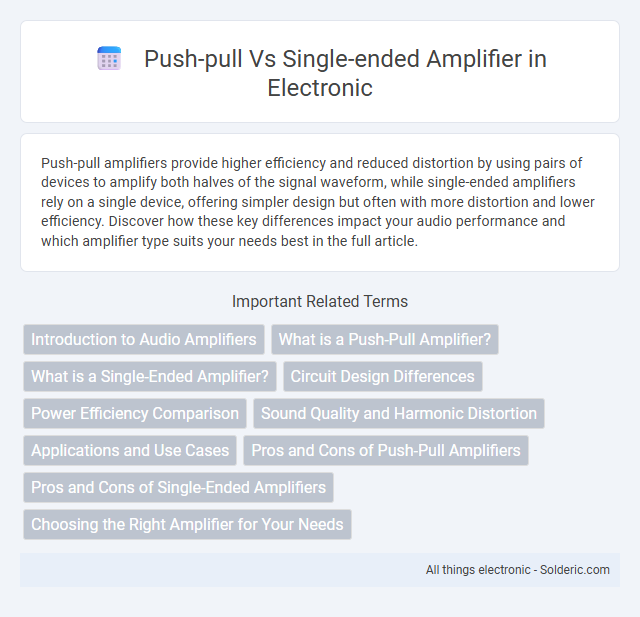Push-pull amplifiers provide higher efficiency and reduced distortion by using pairs of devices to amplify both halves of the signal waveform, while single-ended amplifiers rely on a single device, offering simpler design but often with more distortion and lower efficiency. Discover how these key differences impact your audio performance and which amplifier type suits your needs best in the full article.
Comparison Table
| Feature | Push-Pull Amplifier | Single-Ended Amplifier |
|---|---|---|
| Configuration | Two active devices operating in opposite phases | Single active device amplifying full waveform |
| Distortion | Lower even-order harmonic distortion | Higher distortion, especially even-order harmonics |
| Efficiency | Higher efficiency (up to 70-80%) | Lower efficiency (typically 25-30%) |
| Power Output | Higher output power capability | Limited power output |
| Complexity | More complex circuit design | Simpler circuit design |
| Cost | Generally higher cost due to complexity | Lower cost |
| Applications | High-power audio amplifiers, RF transmitters | Low-power audio devices, instrumentation |
Introduction to Audio Amplifiers
Audio amplifiers, essential in enhancing sound signals, can be broadly classified into push-pull and single-ended designs based on their circuit topology and signal handling. The push-pull amplifier uses complementary transistors to amplify both halves of the audio waveform, resulting in higher power output and reduced distortion. Your choice between push-pull and single-ended amplifiers impacts audio fidelity, efficiency, and complexity in audio systems.
What is a Push-Pull Amplifier?
A push-pull amplifier utilizes a pair of active devices, typically transistors or tubes, that alternately amplify the positive and negative halves of an input signal, improving efficiency and reducing distortion. This configuration cancels even-order harmonics and minimizes common-mode noise, resulting in higher fidelity audio reproduction compared to single-ended amplifiers. Commonly used in audio power stages, push-pull designs achieve greater output power and better linearity than single-ended counterparts.
What is a Single-Ended Amplifier?
A single-ended amplifier uses one active device, such as a transistor or vacuum tube, to amplify the entire input signal waveform, resulting in a simpler circuit design with fewer components. This type of amplifier often exhibits higher distortion and lower efficiency compared to push-pull amplifiers but is valued for its characteristic warm sound in audio applications. Single-ended amplifiers typically deliver lower power output and rely on a direct current bias for operation.
Circuit Design Differences
Push-pull amplifiers utilize two active devices working in opposite phases to drive the load, which cancels even-order harmonics and improves efficiency. Single-ended amplifiers employ a single active device to amplify the entire signal waveform, resulting in simpler circuit design but higher distortion and lower power efficiency. The push-pull configuration often requires transformers or phase splitters, whereas single-ended designs rely on straightforward biasing and fewer components.
Power Efficiency Comparison
Push-pull amplifiers offer higher power efficiency than single-ended designs by utilizing complementary transistor pairs that conduct during opposite halves of the signal cycle, reducing power loss and heat generation. Single-ended amplifiers run one transistor for the entire waveform, resulting in continuous power dissipation and lower efficiency, often around 20-30%. Your choice depends on whether maximizing power efficiency and minimizing distortion are priorities, as push-pull configurations typically achieve efficiencies above 60%.
Sound Quality and Harmonic Distortion
Push-pull amplifiers deliver superior sound quality by canceling even-order harmonic distortion, resulting in cleaner audio reproduction with reduced noise and distortion levels. Single-ended amplifiers often produce richer, warmer tones due to their higher odd-order harmonic distortion, which some audiophiles prefer despite a generally higher distortion rate. Your choice between these amplifier types depends on whether you prioritize accuracy and low distortion or a characteristic warmth and harmonic coloring in sound.
Applications and Use Cases
Push-pull amplifiers excel in high-power audio systems, automotive sound systems, and RF transmission due to their efficiency and reduced distortion. Single-ended amplifiers are preferred in low-power applications like headphone amplifiers, audiophile equipment, and certain radio receivers for their simplicity and characteristic sound quality. Your choice depends on the required power output, linearity, and specific audio fidelity needs.
Pros and Cons of Push-Pull Amplifiers
Push-pull amplifiers offer improved power efficiency and reduced even-order harmonic distortion by using two devices that alternately amplify the input signal, resulting in higher output power and better linearity compared to single-ended amplifiers. However, they are more complex in design, requiring precise matching of components and a phase splitter circuit, which can increase costs and introduce potential distortion if imbalances occur. Despite these challenges, push-pull configurations are preferred in high-power audio and RF applications due to their superior performance in handling larger signals with less distortion.
Pros and Cons of Single-Ended Amplifiers
Single-ended amplifiers offer simplicity in design and produce a warm, natural sound favored by audiophiles, thanks to their minimalistic circuit with fewer components. Their downside includes lower efficiency and higher distortion compared to push-pull amplifiers, making them less suitable for high-power applications. Single-ended designs also generate more heat and consume more power, which can limit their use in modern high-performance audio systems.
Choosing the Right Amplifier for Your Needs
Push-pull amplifiers offer higher efficiency and lower distortion, making them ideal for high-power audio applications or environments requiring minimal harmonic interference. Single-ended amplifiers deliver a warmer, more natural sound with simpler circuitry, preferred for low-power headphone setups or audiophile listening experiences. Selecting the right amplifier depends on balancing power requirements, sound quality preferences, and application-specific needs.
Push-pull vs Single-ended amplifier Infographic

 solderic.com
solderic.com